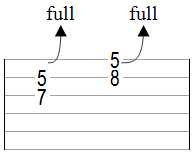New Ways To Play Blues Double Stop String Bends
by Tom Hess
Emotion To Any Guitar Lick

EMAIL TO GET ACCESS
By submitting your info, you agree to send it to Tom Hess Music Corporation who will process and use it according to their privacy policy.
You are about to see & hear cool (but unusual) blues guitar soloing ideas that add a ton of grit to any guitar lick you play.
(These work in every style, not just blues guitar.)
And no, I'm not talking about unison double stop string bends, like this:
Unison double stop string bends are cool, but…
There are many other ways to do double stop string bends most guitarists don’t know.
Best part is:
These guitar lick ideas are easy to play and you can start using them in your very next blues guitar solo.
To begin, check out this blues guitar lesson video that shows you how to play these double stop string bends:
Here are a few lead guitar playing tips that help you implement these double stop string bends into your blues guitar solos:
Blues Guitar Tip #1: Work On Your Vibrato
Vibrato is the heart & solo of any guitar lick. (Especially in blues guitar.) And your double stop string bends will only sound as good as your vibrato.
Here are the things to focus on when you practice vibrato (you can do it on any lick):
- Wrap your hand around the neck of the guitar (in the “blues guitar” playing position).
- Make sure the web between your thumb and index finger is pressed against the back of the guitar neck (this is key to controlled lead guitar vibrato).
- Bend the string up and release it all the way back to the starting note in a steady rhythm. This makes your vibrato in tune and makes your blues guitar playing sound emotional.
Emotion To Any Guitar Lick

EMAIL TO GET ACCESS
By submitting your info, you agree to send it to Tom Hess Music Corporation who will process and use it according to their privacy policy.
When you get good at doing vibrato on a single note, start applying it on double stop string bends. Doing vibrato on double stop string bends is harder than doing it on a single note … but it’s a lead guitar skill well worth mastering.
Watch this lead guitar playing video to help you master blues guitar vibrato:
Blues Guitar Tip #2: Learn Your Blues Guitar Scale Shapes Inside & Out
One of the secrets to being a great lead guitar player (in blues guitar style or not) is knowledge of the fretboard. And to play double stop string bends from the video at the top of the page, you need to know the pentatonic & blues guitar scale patterns all over the guitar.
That’s because the lead guitar variations you saw are based on knowing the blues guitar scale (and other rock guitar scales). The better you know blues guitar scales (and other scales), the easier it is to create guitar lick variations of your double stop string bends.
How to best practice blues guitar scale shapes?
Think about the notes in the blues guitar scale. What you do is take the minor pentatonic scale and add the b5 note. In the key of A minor, the notes are: A C D Eb E G
Your job when memorizing a scale is to find its notes all over the fretboard using scale shapes. (There are as many lead guitar scale shapes as there are notes in the scale.)
In the case of blues guitar scale, there are 6 notes, so there are 6 shapes to learn if you want to master lead guitar.
The good news is: once you learn them, you are all set to play blues lead guitar solos (and create endless guitar lick variations) in any key.
And finding the right notes for the double stop string bends you just learned becomes easy.
Watch this video to see how to best memorize the fretboard for lead guitar playing:
Blues Guitar Tip #3: Vary The Articulation Of Your Lead Guitar Licks
Blues guitar players often talk about making the lead guitar solos speak like a voice. And to do that, you better have more than one way to articulate the notes in any guitar lick you play.
This, in combination with double stop string bends from this article will make all of your blues guitar playing much more expressive.
A commonly neglected lead guitar technique (especially) among blues guitar players is:
Sliding
And I don’t just mean sliding into or out of a note in a guitar lick like most lead guitar players do. I mean also using backslides.
What are backslides?
A backslide is a lead guitar phrasing trick that consists of 3 steps:
1. You play a note in your guitar lick
2. You slide away from that note (up or down), to add lead guitar phrasing to it.
3. You slide back to the note you started from and continue playing your guitar lick.
And no, backslides are NOT the same lead guitar element as "descending slides". A descending slide happens when you slide to any lead guitar note from a higher pitch.
Backslides are easier to demonstrate (and play) than they are to explain…
So, here is a lead guitar lesson video that shows how to add backslides to your blues guitar solos:
Combine these ideas with the double stop string bends you just learned and your blues guitar solos will sound killer!
And getting back to double stop string bends…
Here are some common questions lead guitar players ask me about using double stop string bends in their solos:
Question: “Tom Hess, how do I combine traditional unison double stop string bends and the other double stop string bends from this blues guitar lesson?”
Answer: You can use any blues guitar string bends in any guitar lick at any time. None of these blues guitar ideas are better than others. The key is to have many ways to ornament notes in a guitar lick, not just 1 or 2.
This is especially important when playing blues guitar solos.
Why?
Because in blues guitar, every guitar lick comes from a 5-note scale. So, you are somewhat limited in the number of notes you can use.
And that means:
The more phrasing ideas (like the double stop string bends in this article) you have, the better your blues guitar playing will sound.
And speaking of more double stop string bends…
Check out this advanced blues guitar lesson with even more double stop string bends:
Question: “Tom Hess, how do I know which of the double stop string bends to use when?”
Answer: There is no right answer. Try ALL these double stop string bends and see which ones you like best.
And here is a simple process you can follow to do just that:
Step 0: Make a list of all the double stop string bends you learned so far in this article.
Step 1: Find a blues guitar backing track you like.
Step 2: Improvise a short blues guitar lick (4-6 notes long). Do NOT play a full lead guitar solo. Only play 1 guitar lick. This is important.
Step 3: Select one spot in your guitar lick where to apply double stop string bends.
Step 4: Play the idea from your double stop string bends list 3 times. Make a mental note of how it sounds in the context of your guitar lick.
Step 5: Repeat your guitar lick and play a different idea from your list of double stop string bends. Repeat it 3 times… and make a mental note of how it sounds.
Keep repeating your guitar lick until you go through your entire list of double stop string bends.
This lead guitar refinement practice is a big secret to mastering blues guitar phrasing.
Bonus: You can also experiment with where in the lick you use each idea from your list of double stop string bends. The whole guitar lick will sound different when you change when and where you play double stop string bends. (Even if you don’t change any of its notes.)
For more ideas on how to do this step, check out this lead guitar phrasing eGuide.
Question: “Tom Hess, What are some lead guitar playing mistakes people make when using double stop string bends?”
Answer:
Mistake #1: Not using enough of them in your lead guitar playing. This often happens when you focus more on what notes to play in your guitar licks than on how to play those notes. (i.e. lead guitar phrasing.)
Here is the problem with this:
There aren’t enough notes in any scale to make every lick sound interesting. But with great phrasing, you can make any lead guitar lick sound great.
This means: your lead guitar phrasing is always way more important than the notes you play.
To see how better lead guitar phrasing can transform any guitar lick, check out another blues guitar lesson I taught to a student of mine who wanted help with his lead guitar playing:
Mistake #2: On the flipside, it’s very possible to overuse a certain lead guitar technique (even a cool one like double stop string bends). And when you overuse one technique - you end up ignoring other elements of your lead guitar playing.

The point?
Be careful to not let your lead guitar playing get out of balance. You do this by investing time into all the skills that make you great at playing blues guitar.
Mistake #3: Having a shaky and nervous sounding lead guitar vibrato that’s not in sync with blues guitar track you are soloing over.
Great rock and blues guitar vibrato ought to be in tune & in time.
“In tune” means:
Your vibrato should bend the lead guitar note the same distance each time and release it all the way back down to its starting pitch.
And “in time” means: your vibrato needs to be in sync with the beat of the blues guitar track you are soloing over. This makes your lead guitar licks sound like they fit the song. (And it helps to add more fire to double stop string bends you use in your solo.)
Watch this video to see what I mean:
Bonus blues guitar vibrato tip:
Don’t shake the string from side to side. Wrap your thumb around the neck of the guitar and do vibrato as if you are turning a doorknob. (Do the same when playing double stop string bends in your lead guitar solos.)
Question: “Tom Hess, how can I best combine double stop string bends with other lead guitar phrasing ideas?”
Answer: Start by making a list of all the categories of lead guitar phrasing ornaments you know. (Similar to how you made a list of variations of double stop string bends in the earlier step.)
Then play any guitar lick of your choice. (Again: do NOT play a full blues guitar solo here – just one lick is enough.)
Then ask yourself: “On a lead guitar scale of 1-10, how expressive does this blues guitar lick sound?”
If your answer is anything less than a “10!”, ask yourself: “which lead guitar phrasing ornament(s) might I use to make this lick better?”
Your answer might include one of the double stop string bends. Or it might include some other lead guitar phrasing ornament. The point is: change something in how you play the lick itself.
Keep refining it until you get the sound up to a 10 on the “kickass lead guitar playing” scale.
Question: “Tom Hess, when I try to the guitar lick ideas from this article, my blues guitar playing sounds very noisy. What can I do?”
Here is an easy way to clean up your blues guitar playing:
1. use thumb muting when you play blues guitar. (Rest your picking hand’s thumb on the lower string when you play any guitar lick. This keeps the lower strings of your guitar lick quiet and makes your blues guitar playing a lot cleaner.
2. Mute the highest strings of your guitar lick with the index finger of your fretting hand. Note: don’t barre the higher strings – just rest the finger on the higher strings as you play the guitar lick.
Combine these 2 muting techniques to make your blues guitar solos cleaner.
Bonus blues guitar playing tip: practice every guitar lick you play using distortion. (Use the same amount you’d use for regular lead guitar playing.) This makes you more aware of string noise and helps you fix sloppy blues guitar licks faster.
If you enjoyed this lead guitar article, you’ll love my personalized Breakthrough Guitar Lessons. There, I get to help you reach your specific musical goals, with guitar lessons tailored to your skill level and guitar playing strengths and weaknesses.
Click the green “Start Now” button to learn more:
 About Tom Hess: Tom Hess is a guitar teacher, music career mentor and guitar teacher trainer. He teaches rock guitar lessons online to students from all over the world and conducts instructional live guitar training events attended by musicians from over 50 countries.
About Tom Hess: Tom Hess is a guitar teacher, music career mentor and guitar teacher trainer. He teaches rock guitar lessons online to students from all over the world and conducts instructional live guitar training events attended by musicians from over 50 countries.
 | Forward this article to your friends |

